Genealogical information from the real estate registry: Guide
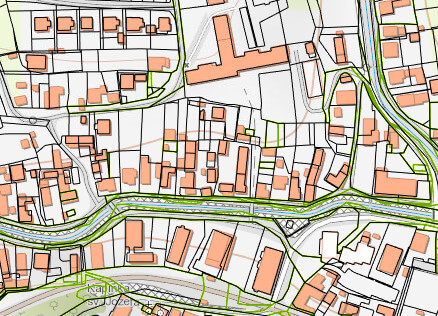
What is the real estate cadastre?
The real estate register is a public register and at the same time an information system containing the geometric designation, inventory and description of real estate and data on rights to them (ownership rights, liens, pre-emptive rights, encumbrances, lease rights, rights arising from the management of state property, municipalities and higher territorial units).
The real estate cadastre consists of cadastral records arranged according to cadastral territories. A cadastral record is a set of documentary materials (title deeds, cadastral map, collection of deeds, etc.) containing data from one cadastral territory. The real estate cadastre serves mainly for the protection of rights to real estate, tax and fee purposes, real estate valuation, protection of agricultural and forest land, creation and protection of the environment, protection of mineral wealth, protection of national and other cultural monuments, as well as protected areas and natural creations, as well as for the construction of other information systems on real estate. The data entered in the cadastre are valid unless proven otherwise.
Real estate rights are recorded in the cadastre in three ways: by deposit, by entry or by note. A deposit has legal effects, i.e. the right to real estate arising from a contract arises, changes or ceases only with the permission of the deposit. Unlike a deposit, a record has only registration effects, it records rights to real estate that have already arisen, changed or ceased by law, by decision of a state authority, by hammering at a public auction or on the basis of a public or other document (e.g. registration of a certificate of inheritance). A note serves only to temporarily indicate facts relating to the real estate or a person (e.g. a preliminary court order prohibiting the disposal of real estate). In this context, we would also like to mention a seal, which has a preventive effect and, if recorded in the title deed, signals that the registered right is subject to a certain change (e.g. cadastral proceedings to correct an error have begun).
The cadastre records: cadastral territories, land, buildings connected to the ground by a solid foundation, apartments, apartments under construction, non-residential premises and non-residential premises under construction, protected parts of nature and landscape and cultural monuments, rights to real estate. Engineering structures and small buildings that are only shown on the cadastral map by the land parcel number or map mark and marked with a code for the type and method of land use are not recorded in the cadastre.
A title deed is a document proving ownership of a property. The title deed contains the number, name of the district, municipality and cadastral area and consists of
three parts:
In part A. the property status lists and specifies all properties to which the title deed relates.
In part B. owners and authorized persons contains personal or identification data of the owners and authorized persons, the method and date of acquisition of real estate.
In part C. encumbrances may include information indicating restrictions on the use of real estate (e.g. lien, encumbrance, right of pre-emption).
Why use the real estate cadastre for genealogical research?
The land registry is one of the most valuable sources of information for genealogical research, as it provides historical data on property owners that can reveal important family connections. Through land registry records, it is possible to find out where and when ancestors owned property, and even reveal family relationships such as inheritance connections, marriages, or co-ownership ties.
These records can allow a genealogist to trace a family's movements within a particular area or municipality, as the cadastral records record not only current ownership relationships but also historical data about previous owners. If family members have lived in the same place for generations, the cadastral records can be key to tracking their shared heritage and life changes, such as through sales, gifts, or inheritance of property.
The cadastre also provides details of restrictions attached to real estate, such as liens, encumbrances, and pre-emption rights, which provides a deeper insight into the legal aspects of the property and the personal relationships between individual owners. Such information is valuable for compiling a detailed family tree that includes not only names and dates, but also the family's financial background and social status.
Explanation of relationships between persons on the title deed
The title deed provides important information about ownership and legal relationships to real estate. There may be multiple people on one property, and their relationships may be diverse. These relationships can be identified and explained through three main parts of the title deed:
Part A – Assets:This section describes the properties to which the title deed applies. The type of property (e.g. land, apartment) and its characteristics are listed here, but the relationships between the persons are not yet listed here.
Part B – Owners and Beneficiaries:This section contains the identification data of all owners or persons with rights to the property. For each person, the method and date of acquisition of rights (for example, inheritance, purchase, donation) is indicated, which may indicate family or other legal ties between the individual owners. If there are several co-owners of the property, their shares may be expressed as a percentage, and it is also possible to distinguish between forms of co-ownership, such as joint or joint ownership of spouses.
Part C – Burdens:This section records restrictions and encumbrances on the property, such as liens, encumbrances, pre-emptive rights, or other legal obligations. Such entries may reflect legal relationships between owners and third parties or between co-owners, thus providing context to the legal relationships on the property.
Relationships between individuals on a title deed may indicate family connections, such as inheritance, joint ownership within the family, or joint investments. Genealogical research can, by analyzing these relationships, reveal hidden connections between individual family members, property transactions, or reasons for the division of property among heirs.
Procedure for obtaining data from the cadastre for genealogical purposes
Start your search by clicking on the page https://zbgis.skgeodesy.sk
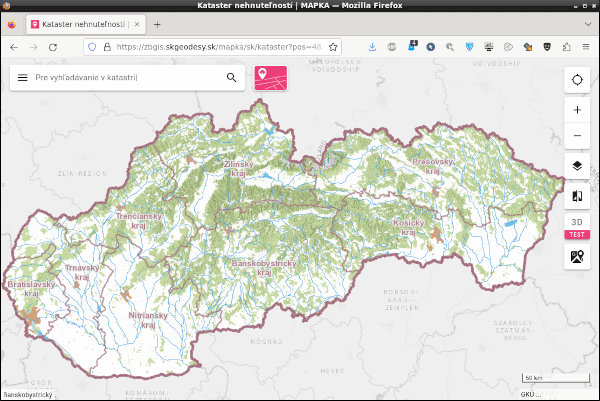
Enter the name of the village in the search and click on the castle.
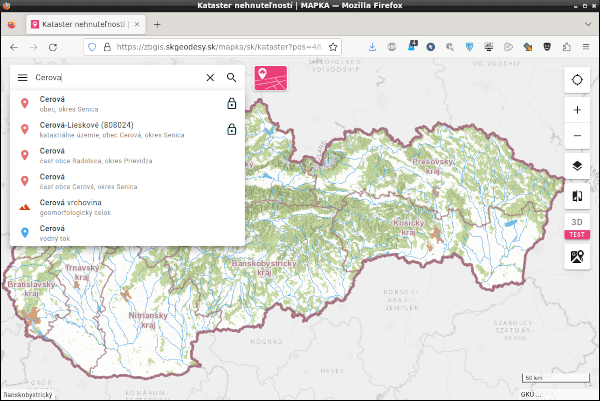
In the same field, start typing the person's last name. If there are too many people, you can also add their first name.
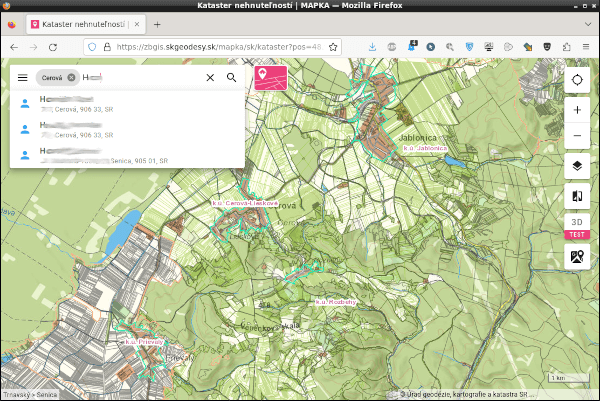
Now either click on the person they offer you, or press enter and all people who match your search will be listed in the pink part of the window.
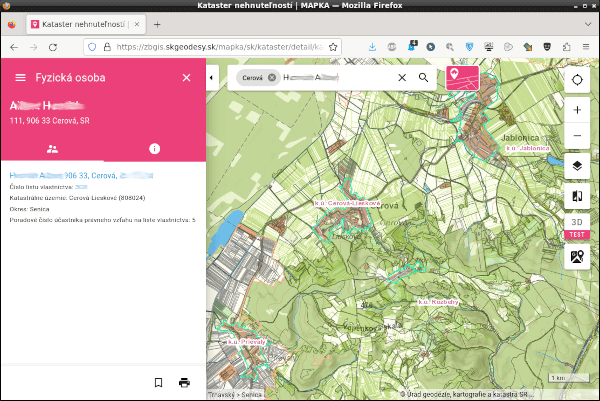
Now all that remains is to choose whether you want to see where the house or land to which the title deed relates is located.
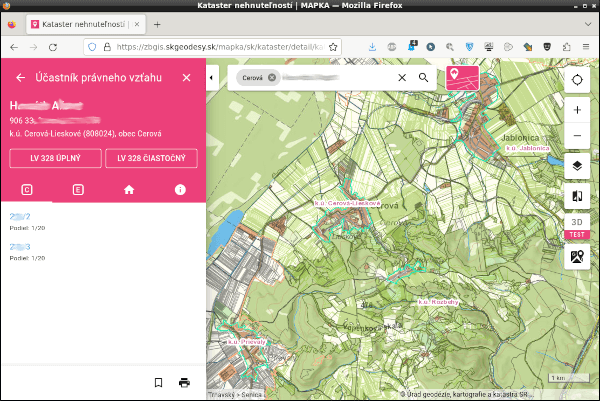
Now click to view the full LV including the persons who have a share in the ownership. Fractions will help you determine the relationship between the persons.
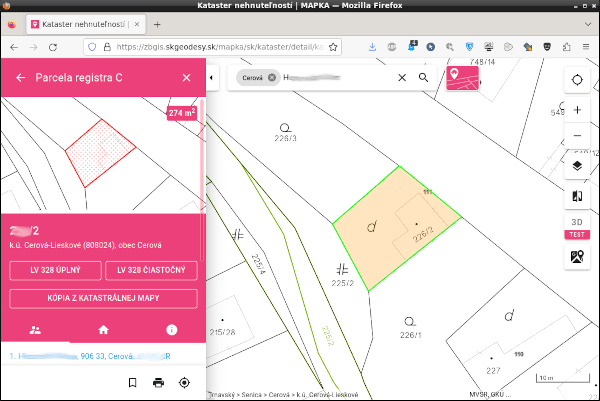
Fractions and estimating family relatedness
The last column of the title deed shows the fraction of ownership in the whole. This fraction can provide information about the relationships between the individual owners, as it expresses their share of the property. These shares can be a valuable source of information for genealogical research, but they also require analysis of other data, such as surnames, dates of birth, and the method of acquisition of ownership.
There are cases where fractions have minimal informative value - for example, in the case of land under apartment buildings, where the ownership of each apartment owner represents a negligible part of the whole and is not related to direct family relationships.
Examples of interpreting fractions to determine kinship relationships
Example 1:Owners and their shares:
- 1. owner 1/5
- 2. owner 1/5
- 3. owner 1/25
- 4. owner 1/25
- 5. owner 1/25
- 6. owner 1/25
- 7. owner 1/25
- 8. owner 1/5
- 9. owner 1/5
Interpretation: From the above distribution of shares, it can be deduced that the owners with a 1/5 share (1st, 2nd, 8th and 9th owners) are probably siblings. A 1/5 share for each of them indicates equal inheritance rights, probably from a common parent or parents. The owners with a smaller share of 1/25 (3rd, 4th, 5th, 6th and 7th owners) may be children of one of the siblings, which makes them nephews and nieces of the first four owners. The lower share indicates that they inherited the property in smaller parts, which may mean that they inherited from one of the original co-owners.
2. Example: Parents and childrenOwners and their shares:
- 1st owner: 1/2 (probably parent)
- 2nd owner: 1/4 (probably a child)
- 3rd owner: 1/4 (probably a child)
Interpretation: In this case, the first owner with a 1/2 share is likely to be the parent, while the other two owners with a 1/4 share are the children. A similar division is common in inheritance situations, where the surviving parent receives half of the estate and the children share the remaining half equally.
3. Example: CousinsOwners and their shares:
- 1. owner: 1/6
- 2. owner: 1/6
- 3. owner: 1/6
- 4. owner: 1/12
- 5. owner: 1/12
- 6. owner: 1/12
- 7. owner: 1/12
- 8. owner: 1/12
- 9. owner: 1/12
Interpretácia: Owners with a 1/6 share (1st, 2nd, 3rd owner) may be siblings who inherited from their common parents. Smaller shares of 1/12 (4th to 9th owner) may belong to cousins or children of the original sibling who died and whose children inherited in smaller fractions.
Summary
In genealogical research, it is important to examine the fragments of a title deed in the context of other data, such as dates of birth and surnames. This approach allows genealogists to more accurately determine the kinship relationships between individual owners and identify family lines that would otherwise remain hidden. Such records are a valuable source of information about how property was passed down through the generations, which can significantly enrich a genealogical family tree. Enjoy long winter evenings searching.
